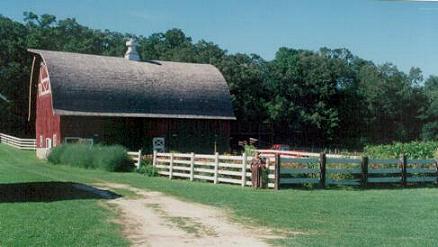|
|
D. Bygdelag, Day 3:
Saturday morning was cooler and fresher after the rain of the previous night. The two week heat wave had broken at last. We had breakfast again in the cafeteria and spent the morning attending the forum presentations. Keith was particularly impressed by a speaker who was the director of the Emigrant Museum north of Oslo, Norway. Among other things, he spoke of the recent resurgence of interest the Norwegians are showing in Norwegian-Americans, their settlement in America and how their descendants fared. Many Norwegians are also apparently trying to trace down distant relatives living in this country. Peg attended an interesting presentation on storytelling as it relates to the simple telling of stories about individuals collecting information for family histories. The presenter's position was that it is through simple individual stories that we come to appreciate who we are, where we have come from and what our future may hold.
Peg and Keith both attended a presentation by Ann Gesme, an educator and author from Wisconsin and Minnesota. She is most well known as the author of the book, BETWEEN ROCKS AND HARD PLACES (subtitled: Traditions, customs, and conditions in Norway during the 1800s, emigration from Norway, the immigrant community in America), a book Keith had read and Peg is now reading. She spoke on life in rural Norway in the 1800's as well as sharing personal experiences of living in strong Norwegian-American communities and trying to pass on some appreciation of Norwegian heritage to her children. She was an excellent speaker and an interesting person. Her presentation was a delight to attend.
Next it was a walk to the edge of the campus where a Sami (Laplander) encampment was set up complete with reindeer and hide covered teepees. This group was from northern Wisconsin and these folks were very anxious to tell of their heritage and the Sami way of life, but the reindeer were rather unhappy about the warm weather. Then it was time for the lag meetings and we met with the small group that made up Rogalandslag. Organizational business was attended to briefly, then more grumbling about the banner problem.
We then left campus to have a late lunch in the little Norwegian restaurant next to the Vesterheim Museum. This Norwegian meal, which consisted of borsch (a cold, thick beet soup) and a lefse-wrap, was much more enjoyable than our first try at authentic Norwegian cuisine. After lunch we drove north of Decorah where we did a quick tour of the picturesque Seed Savers Heritage Farm which is part of the Seed Savers Exchange. The latter is a nonprofit organization dedicated to the preservation of endangered vegetables and fruits. Peg had written a paper on them while in college. The farm's gift shop was a good place to buy some heirloom vegetable and flower seeds for our son Kent.
By late Saturday afternoon it was time to return to campus and a Norwegian banquet in the cafeteria. The food was good as well as interesting. Most enjoyable however was the company we had at our large cafeteria table. Actually eating in the cafeteria was one of the most enjoyable parts of the bygdelag. Of course we all wore name tags that also told where we were from. Sitting with strangers at every meal the conversation inevitably started around where we each were from. Of course most of the attendees were from the Midwest with Iowa, Minnesota, Wisconsin and the Dakotas predominating. Surprisingly though there were many from the Pacific Northwest and California. The conversation would usually next shift to one's connection to Norway, what lag or lags you belonged to, and what was the story about your Norwegian ancestors. Most folks there where not too many generations removed from an actual immigrant or were raised in one of the Midwestern Norwegian-American communities and, therefore, had certain familiarity with the customs and not a few spoke the language extremely well. Many had made frequent and recent trips to Norway.
We, as 5th generation Americans on our Norwegian side, have experienced considerable "watering down" of our heritage. For all practical purposes it is zero. Knowing about the Slooper Book was all the Norwegian heritage we've ever had. People seemed tolerant of our ignorance and were very willing to try to help us learn more about our heritage. Of course the pressure was on from some to join the Sons of Norway. Through that, we learned of at least two West coast celebrations that we will probably go to.
The last evening program (Saturday) featured the call of the lur as opener and then consisted of several musical presentations. There was a comedy Norwegian-American singing group and the Decorah Men's Singing Society. This latter group ranged in age from young college students to those old and feeble. Instead of gathering at the local bar, they gather at the local Lutheran Church every Monday night to sing. They presented lively renditions of Norwegian folk and classical music as well as gospel tunes. The last musical group explained that they were really a Norwegian-American dance ensemble and invited audience participation in the dancing. Folks in and out of costume came up to the stage, with the Norwegian dance troupe participating in full regalia and full enthusiasm.
There was a tad of dancing at Marty's again, but the program had been so late there were only 20 minutes before 10pm closing. With two couples we'd recently met, we adjourned to the dorm lounge for another couple of hours of pleasant visiting and getting acquainted.
|
|